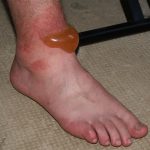 Thin vesicle on the skin containing serum and caused by rubbing, friction or burn.
Thin vesicle on the skin containing serum and caused by rubbing, friction or burn.
A swelling on the skin containing serum from the blood, caused by rubbing, burning or a disease such as chickenpox.
Vesicle filled with serum; collection of fluid below the skin, usually resulting from a bum.
A collection of fluid under the epidermis or within the epidermis.
A small swelling of the skin filled with fluid; also known as a vesicle or bulla. Blisters can develop anywhere that the skin experiences friction and frequently occur on the feet. Groups of blisters or blisters involving more than one body location should be evaluated by a doctor for proper treatment. Although they are common and, in most cases, minor injuries, blisters require attention to prevent infection. They must be covered with an adhesive bandage or gauze pad and should not be punctured unless they are painful or prevent a person from performing essential activities such as walking. Large blisters should only be punctured by a dermatologist.
A swelling containing watery fluid (serum) and sometimes also blood (blood blister) or pus, within or just beneath the skin. Blisters commonly develop as a result of unaccustomed friction on the hands or feet or at the site of a bum. Blisters may be treated with antiseptics and dressings. An unduly painful blister may be punctured with a sterile needle so that the fluid is released.
A collection of fluid below or within the epidermis.
Blisters are inflamed burns caused by the friction of skin against a fabric or surface (such as a shoe).
An assemblage of fluid beneath the external layer of the skin manifests as an elevated region. This fluid comprises serum, which has seeped from blood vessels in the underlying layers of the skin following slight injury. Its purpose is to safeguard the damaged tissue, providing a protective barrier.
Blisters can arise from various causes, with burns and friction being common culprits. Additionally, certain skin conditions such as eczema, epidermolysis bullosa, impetigo, erythema multiforme, pemphigus, pemphigoid, dermatitis herpetiformis, and specific types of porphyria can also lead to blister formation. Chickenpox, herpes zoster (shingles), and herpes simplex infections are known to cause the development of small blisters. It is generally recommended to refrain from puncturing blisters, as they are most effective when left undisturbed. However, medical attention should be sought for large or unexplained blisters.
A fluid-filled bump or blister that forms within or on the surface of the skin.
